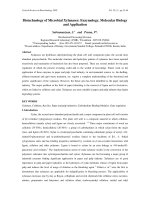Overview of microbial life
Bạn đang xem bản rút gọn của tài liệu. Xem và tải ngay bản đầy đủ của tài liệu tại đây (1.74 MB, 71 trang )
<span class="text_page_counter">Trang 1</span><div class="page_container" data-page="1">
<b>OVERVIEW OF MICROBIAL LIFE</b>
<b><small>Tran Thi My Hanh, PhD.</small></b>
</div><span class="text_page_counter">Trang 3</span><div class="page_container" data-page="3"><b>WHAT ARE MICROORGANISMS?</b>
<small></small> Microscopic living organisms, single-celled or multicellular
<small></small> Including: Prokaryotes (archaea, bacteria) and eukaryotes (algae, fungi, protozoa) and viruses.
</div><span class="text_page_counter">Trang 4</span><div class="page_container" data-page="4"><small> </small><b><small>Internal structure of microbial cells. Note differences in scale and </small></b>
<small>internal structure between the prokaryotic and eukaryotic cells. </small>
</div><span class="text_page_counter">Trang 5</span><div class="page_container" data-page="5"><b>ELEMENTS OF CELL AND VIRAL STRUCTURE </b>
<small></small> All cells have much in common and contain many of the same components.
<small>Cytoplasmic membrane: The cell’s permeability barrier; encloses the cytoplasm </small>
<small>Cytoplasm: The fluid portion of a cell, bounded by the cytoplasmic membrane </small>
<small>Ribosome: A cytoplasmic particle that functions in protein synthesis </small>
</div><span class="text_page_counter">Trang 6</span><div class="page_container" data-page="6"><b>PROKARYOTIC AND EUKARYOTIC CELLS</b>
<small></small>
Prokaryote: A cell that lacks a membrane enclosed nucleus and other organelles
<small></small>
Eukaryote: A cell having a membrane-bound nucleus and usually other membrane-bound organelles
<small></small>
Nucleus: A membrane-enclosed structure that contains the chromosomes in eukaryotic cells
<small></small>Organelle: A unit membrane-enclosed structure
such as a mitochondrion or chloroplast present in the cytoplasm of eukaryotic cells
</div><span class="text_page_counter">Trang 7</span><div class="page_container" data-page="7"><b>CELL SIZE </b>
<small></small> In general, microbial cells are very small,
particularly prokaryotes. For example, a typical rod-shaped prokaryote is 1–5 µm long and about 1 µm wide and thus is invisible to the naked eye.
<small></small> Eukaryotic cells are known to have diameters as small as 0.8 µm or as large as several hundred micrometers.
</div><span class="text_page_counter">Trang 8</span><div class="page_container" data-page="8"><small></small>
Virus: A genetic element that contains either DNA or RNA and replicates in cells; has an extracellular form
<small></small>
Viruses: A major class of microorganisms, but they are not cells. Viruses lack many of the
attributes of cells
<small></small>
Viruses are known to infect all types of cells, including microbial cells. Many viruses cause disease in the organisms they infect
</div><span class="text_page_counter">Trang 9</span><div class="page_container" data-page="9"><b><small> Virus structure and size comparisons of viruses and cells. (a) </small></b>
</div><span class="text_page_counter">Trang 10</span><div class="page_container" data-page="10"><b>ARRANGEMENT OF DNA IN MICROBIAL CELLS </b>
<small></small> The life processes of all cells are governed by their
<b>complement of genes, their genome (the </b>
complement of genes in an organism)
<small></small> A gene can be defined as a segment of DNA that encodes a protein or an RNA molecule.
</div><span class="text_page_counter">Trang 11</span><div class="page_container" data-page="11"><b>NUCLEUS VERSUS NUCLEOID</b>
<small>The genomes of prokaryotic and eukaryotic cells are organized differently </small>
<small>In prokaryotic cells, DNA is present in a large double-stranded molecule called the chromosome. The chromosome aggregates within the cell to form a mass visible in the electron microscope, </small>
<b><small>called the nucleoid. Most prokaryotes have only a single </small></b>
<small>chromosome. Because of this, they typically contain only a single copy of each gene and are therefore genetically </small><b><small>haploid</small></b><small>. Many prokaryotes also contain small amounts of circular </small>
<b><small>extrachromosomal DNA called plasmids (an extrachromosomal </small></b>
<small>genetic element nonessential for growth)</small>
<small>Eukaryotes typically contain two copies of each gene and are thus genetically </small><b><small>diploid</small></b><small>. During cell division in eukaryotic cells the </small>
<small>nucleus divides (following a doubling of chromosome number) in the process called mitosis</small>
</div><span class="text_page_counter">Trang 13</span><div class="page_container" data-page="13"><b>GENES, GENOMES, AND PROTEINS</b>
<small></small> How many genes and proteins does a cell have? <small></small> <i>The genome of Escherichia coli, a typical </i>
prokaryote, is a single circular chromosome of 4.68 million base pairs of DNA, about 4,300 genes and about 1,900 different kinds of proteins and a total of about 2.4 million protein molecules.
<small></small> Eukaryotic cells typically have much larger genomes than prokaryotes. A human cell, for
example, contains over 1,000 times as much DNA
<i>as a cell of E. coli and about seven times as many </i>
genes.
</div><span class="text_page_counter">Trang 14</span><div class="page_container" data-page="14"><b>THE EVOLUTIONARY TREE OF LIFE </b>
<small></small> Evolution: Change in a line of descent over time
leading to new species or varieties within a species <small></small> Evolution occurs in any self-replicating system in
which variation occurs as the result of mutation and selection and differential fitness is a potential result.
</div><span class="text_page_counter">Trang 15</span><div class="page_container" data-page="15"><b>DETERMINING EVOLUTIONARY RELATIONSHIPS </b>
<small></small> The evolutionary relationships between organisms are
<b>the subject of phylogeny</b>
<small></small> Phylogenetic relationships between cells can be deduced by comparing the genetic information (nucleotide or
amino acid sequences) that exists in their nucleic acids or proteins
<small></small> Because all cells contain ribosomes (and thus rRNA), this molecule can and has been used to construct a
phylogenetic tree of all cells, including microorganisms <small></small> Viral phylogenies have also been determined, but
because these microorganisms lack ribosomes, other molecules have been used as evolutionary barometers
</div><span class="text_page_counter">Trang 16</span><div class="page_container" data-page="16"><b><small>Ribosomal RNA (rRNA) gene sequencing and phylogeny. (a) Cells </small></b>
</div><span class="text_page_counter">Trang 17</span><div class="page_container" data-page="17"><b>THE THREE DOMAINS OF LIFE </b>
<small></small> From comparative rRNA sequencing, three
phylogenetically distinct lineages of cells have been identified
<small></small> <b>The lineages, called domains (the highest level of biological classification), are the Bacteria and the </b>
<b>Archaea (both consisting of prokaryotes) and the Eukarya (eukaryotes) </b>
</div><span class="text_page_counter">Trang 18</span><div class="page_container" data-page="18"><small>The phylogenetic tree of life as defined by comparative rRNA gene sequencing. </small>
</div><span class="text_page_counter">Trang 20</span><div class="page_container" data-page="20"><b>PHYSIOLOGICAL DIVERSITY OF MICROORGANISMS </b>
<small></small> Energy can be obtained from three sources in
nature: organic chemicals, inorganic chemicals, and light
</div><span class="text_page_counter">Trang 21</span><div class="page_container" data-page="21"><b><small>Metabolic options for conserving energy. The organic and inorganic </small></b>
<small>chemicals listed here are just a few of the many different chemicals used by various chemotrophic organisms. Chemotrophic organisms oxidize organic or inorganic chemicals, which yields ATP. Phototrophic organisms convert solar energy to chemical energy in the form of ATP. </small>
</div><span class="text_page_counter">Trang 22</span><div class="page_container" data-page="22"><b>CHEMOORGANOTROPHS </b>
<small></small>
Organisms that obtain energy from chemicals are called chemotrophs, and those that use organic chemicals are called
<b>chemoorganotrophs </b>
<small></small>
Some microorganisms can extract energy from an organic compound only in the presence of oxygen; these organisms are called aerobes.
Others can extract energy only in the absence of oxygen (anaerobes). Still others can break down organic compounds in either the presence or
absence of oxygen. Most microorganisms that have been brought into laboratory culture are chemoorganotrophs.
</div><span class="text_page_counter">Trang 23</span><div class="page_container" data-page="23"><b>CHEMOLITHOTROPHS </b>
<small></small>
Many prokaryotes can tap the energy available in inorganic compounds. This is a form of
metabolism called chemolithotrophy and is carried out by organisms called
<b>chemolithotrophs </b>
<small></small>
Chemolithotrophy is a process found only in prokaryotes and is widely distributed among species of Bacteria and Archaea.
<small></small>
The spectrum of different inorganic compounds used is quite broad, but typically, a particular group of prokaryotes specializes in the use of a related group of inorganic compounds.
</div><span class="text_page_counter">Trang 24</span><div class="page_container" data-page="24"><b>PHOTOTROPHS </b>
<small></small>
Phototrophic microorganisms contain pigments that allow them to use light as an energy source, and thus their cells are colored
<small></small>
Two major forms of phototrophy are known in prokaryotes. In one form, called oxygenic
photosynthesis, oxygen (O
<sub>2</sub>) is produced. Among microorganisms, oxygenic photosynthesis is
characteristic of cyanobacteria, algae, and their phylogenetic relatives. The other form,
anoxygenic photosynthesis, occurs in the purple and green bacteria and does not result in O
<sub>2</sub>production
</div><span class="text_page_counter">Trang 25</span><div class="page_container" data-page="25"><b>HETEROTROPHS AND AUTOTROPHS </b>
<small></small> All cells require carbon as a major nutrient. Microbial cells
<b>are either heterotrophs, which require one or more </b>
organic compounds as their carbon source, or
<b>autotrophs, which use carbon dioxide (CO</b><sub>2</sub>) as their carbon source
<small></small> Chemoorganotrophs are by definition heterotrophs. By contrast, most chemolithotrophs and virtually all
phototrophs are autotrophs.
<small></small> Autotrophs are sometimes called primary producers because they synthesize organic matter from CO2 for both their own benefit and that of chemoorganotrophs
</div><span class="text_page_counter">Trang 27</span><div class="page_container" data-page="27"><b><small>Phylogenetic tree of Bacteria. The relative sizes of the colored boxes </small></b>
</div><span class="text_page_counter">Trang 28</span><div class="page_container" data-page="28"><small></small> The largest phylum of Bacteria that includes many of the
<i>common gram-negative bacteria, such as Escherichia </i>
<i>coli. It includes many chemoorganotrophic bacteria and </i>
also several phototrophic and chemolithotrophic species <small></small> Several other common prokaryotes of soil and water,
and species that live in or on plants and animals in both harmless and disease-causing ways, are members of the
<i>Proteobacteria. These include species of Pseudomonas, </i>
many of which can degrade complex and otherwise toxic natural and synthetic organic compounds, and
<i>Azotobacter, a nitrogen-fixing bacterium. A number of </i>
<i>key pathogens are Proteobacteria, including Salmonella, </i>
<i>Rickettsia, Neisseria, and many others. </i>
</div><span class="text_page_counter">Trang 30</span><div class="page_container" data-page="30"><b>GRAM-POSITIVE BACTERIA </b>
<small></small>
The gram-positive phylum of Bacteria
(contains many organisms that are united by their common phylogeny and cell wall
<i>structure: the endospore-forming Bacillus, </i>
<i>Clostridium and related spore-forming </i>
bacteria such as the antibiotic-producing
<i>Streptomyces, the lactic acid bacteria, </i>
common inhabitants of decaying plant material and dairy products that include
<i>organisms such as Streptococcus and </i>
<i>Lactobacillus. And the Mycoplasmas </i>
</div><span class="text_page_counter">Trang 31</span><div class="page_container" data-page="31"><b><small>Gram-positive bacteria. (a) The rod-shaped endospore-forming </small></b>
<small>bacterium Bacillus, here shown as cells in a chain. (b) Streptococcus, a spherical cell that exists in chains. </small>
</div><span class="text_page_counter">Trang 32</span><div class="page_container" data-page="32"><small></small> Prokaryotic oxygenic phototrophs and phylogenetic
<i>relatives of gram-positive bacteria </i>
<small></small> The photosynthetic organelle of eukaryotic phototrophs,
<i>the chloroplast is related to the Cyanobacteria </i>
<small></small> <i>Cyanobacteria were critical in the evolution of life, as they </i>
were the first oxygenic phototrophs to evolve on Earth. The production of O<sub>2</sub> on an originally anoxic Earth paved the way for the evolution of prokaryotes that could respire using oxygen. The development of higher organisms,
such as the plants and animals, followed billions of years later when Earth had a more oxygen-rich environment
</div><span class="text_page_counter">Trang 33</span><div class="page_container" data-page="33"><b><small>Filamentous cyanobacteria. (a) Oscillatoria, (b) Spirulina. Cells of </small></b>
<small>both organisms are about 10 µm wide. </small>
</div><span class="text_page_counter">Trang 34</span><div class="page_container" data-page="34"><b>OTHER MAJOR PHYLA OF BACTERIA </b>
<small></small> <i>Several lineages of Bacteria contain species with unique morphologies. These include the aquatic Planctomyces </i>
group, characterized by cells with a distinct stalk that
allows the organisms to attach to a solid substratum and
<i>the helically shaped spirochetes </i>
<small></small> <i>Two other major lineages of Bacteria are phototrophic: the green sulfur bacteria and the green nonsulfur bacteria (Chloroflexus group) Species in both of these lineages </i>
contain similar photosynthetic pigments and are also autotrophs.
<small></small> <i>Other major lineages of Bacteria include the Chlamydia and Deinococcus groups </i>
</div><span class="text_page_counter">Trang 35</span><div class="page_container" data-page="35"><small> The morphologically unusual stalked bacterium Planctomyces. </small>
</div><span class="text_page_counter">Trang 36</span><div class="page_container" data-page="36"><b><small>Spirochetes. Scanning electron micrograph of a cell of </small></b><small>Spirochaeta zuelzerae. The cell is about 0.3 µm wide and tightly coiled. </small>
</div><span class="text_page_counter">Trang 37</span><div class="page_container" data-page="37"><b><small>Phototrophic green bacteria. (a) </small></b><small>Chlorobium (green sulfur </small>
<small>bacteria). A single cell is about 0.8 µm wide. (b) Chloroflexus (green nonsulfur bacteria). A filament is about 1.3 µm wide. Despite sharing many features such as pigments and photosynthetic membrane </small>
<small>structures, these two genera are phylogenetically distinct </small>
</div><span class="text_page_counter">Trang 39</span><div class="page_container" data-page="39"><b>ARCHAEA </b>
<small></small>
<i>Two phyla exist in the domain Archaea, the </i>
<i>Euryarchaeota and the Crenarchaeota Each </i>
of these forms a major branch on the archaeal tree.
<small></small>
<i>Most cultured Archaea are extremophiles, </i>
with species capable of growth at the highest temperatures, salinities, and extremes of pH of all known
<i>microorganisms. The organism Pyrolobus </i>
for example, is one of the most thermophilic of all known prokaryotes
</div><span class="text_page_counter">Trang 40</span><div class="page_container" data-page="40"><small> </small><b><small>Phylogenetic tree of Archaea</small></b><small>. The organisms circled in red are </small>
</div><span class="text_page_counter">Trang 41</span><div class="page_container" data-page="41"><small>Pyrolobus. This hyperthermophile grows optimally above the boiling point of water. The cell is 1.4 µm wide. </small>
</div><span class="text_page_counter">Trang 42</span><div class="page_container" data-page="42"><i><b>EURYARCHAEOTA </b></i>
<small></small>
<i>The Euryarchaeota branch on the tree of </i>
<i>Archaea contains three groups of organisms </i>
that have dramatically different
physiologies, the methanogens, the extreme halophiles, and the thermoacidophiles.
<small></small>
Some of these require O
<sub>2</sub>whereas others are killed by it, and some grow at the upper or lower extremes of pH
</div><span class="text_page_counter">Trang 44</span><div class="page_container" data-page="44"><small> </small>Extremely acidophilic Archaea. The organism Thermoplasma lacks a cell wall. The cell measures 1 µm wide.
</div><span class="text_page_counter">Trang 45</span><div class="page_container" data-page="45"><i><b>CRENARCHAEOTA </b></i>
<small></small>
<i>The vast majority of cultured Crenarchaeota are </i>
hyperthermophiles
<small></small>
These organisms are either chemolithotrophs or chemoorganotrophs and grow in such
high-temperature environments as hot springs and hydrothermal vents (deep-sea hot springs).
<small></small>
For the most part these organisms are anaerobes (because of the high temperature, their habitats are typically anoxic), and many of them use
hydrogen gas (H
<sub>2</sub>) present in their geothermal habitats as an energy source
</div><span class="text_page_counter">Trang 46</span><div class="page_container" data-page="46"><b>PHYLOGENETIC ANALYSES OF NATURAL MICROBIAL </b>
<b>COMMUNITIES </b>
<small></small> Although microbiologists believe that thus far we
<i>have cultured only a small fraction of the Archaea and Bacteria that exist in nature, we still know a lot </i>
about their diversity. This is because it is
<b>possible to do phylogenetic analyses on rRNA genes present in a natural sample without first having to culture the organisms that contain them.</b>
</div><span class="text_page_counter">Trang 47</span><div class="page_container" data-page="47"><b> EUKARYOTIC MICROORGANISMS</b>
<small></small>
Eukaryotic microorganisms are related by their distinct cell structure and phylogenetic history
<small></small>
<i>Inspection of the domain Eukarya shows </i>
plants and animals to be farthest out on the branches of the tree
<small></small>
Most of these early eukaryotes are
parasites of humans and other animals, unable to live a free and independent existence
</div><span class="text_page_counter">Trang 48</span><div class="page_container" data-page="48"><b><small>Phylogenetic tree of Eukarya. Some early-branching species of </small></b>
<small>Eukarya lack organelles other than the nucleus. Note that plants and animals branch near the apex of the tree. Not all known lineages of Eukarya are depicted. </small>
</div><span class="text_page_counter">Trang 49</span><div class="page_container" data-page="49"><b>EUKARYOTIC MICROBIAL DIVERSITY </b>
<small>A diverse array of eukaryotic microorganisms is known. </small>
<small>Collectively, microbial eukaryotes are called protists, and major groups are algae, fungi, protozoa, and slime molds </small>
<small>Algae contain chloroplasts and can live in environments </small>
<small>containing only a few minerals (for example, K, P, Mg, N, S), water, CO</small><sub>2</sub><small>, and light. Algae inhabit both soil and aquatic </small>
<small>habitats and are major primary producers in nature. </small>
<small>Fungi lack photosynthetic pigments and are either unicellular (yeasts) or filamentous (molds). Cells of algae and fungi have cell walls, whereas the protozoa do not. Protozoans are </small>
<small>typically motile, and different species are widespread in nature in aquatic habitats or as pathogens of humans and other </small>
<small>animals</small>
</div><span class="text_page_counter">Trang 52</span><div class="page_container" data-page="52"><b>SEEING THE VERY SMALL: MICROSCOPY</b>
<small></small>
Visualization of microorganisms requires a microscope, either a light microscope or an electron microscope.
<small></small>
In general, light microscopes are used to look at intact cells at relatively low
<b>magnification </b>
<small></small>
Electron microscopes are used to look at internal cell structure and the details of cell surfaces at very high <b>magnification</b>
</div><span class="text_page_counter">Trang 53</span><div class="page_container" data-page="53"><small></small>
All microscopes employ lenses that magnify the original image
<small></small>
<b>Resolution in microbiology is the ability to </b>
distinguish two objects as distinct and separate under the microscope
<small></small>
<b>Magnification</b> is the ratio of an object’s image to its real size
</div><span class="text_page_counter">Trang 54</span><div class="page_container" data-page="54"><b>THE COMPOUND LIGHT MICROSCOPE</b>
<small></small>
The minimum resolution of a light
microscope is about 2 microns, the size of a small bacterium
<small></small>
Light microscopes can magnify effectively to about 1,000 times the size of the actual
<small></small>
At higher magnifications, the image blurs.
<small></small>Several types of light microscopes are
commonly used in microbiology: bright-field, phase-contrast, dark-field, and
fluorescence
. </div><span class="text_page_counter">Trang 55</span><div class="page_container" data-page="55">(a) A compound light microscope. (b) Path of light through a compound light microscope. Besides 10×, eyepieces (oculars) are available in 15–30×
</div>








